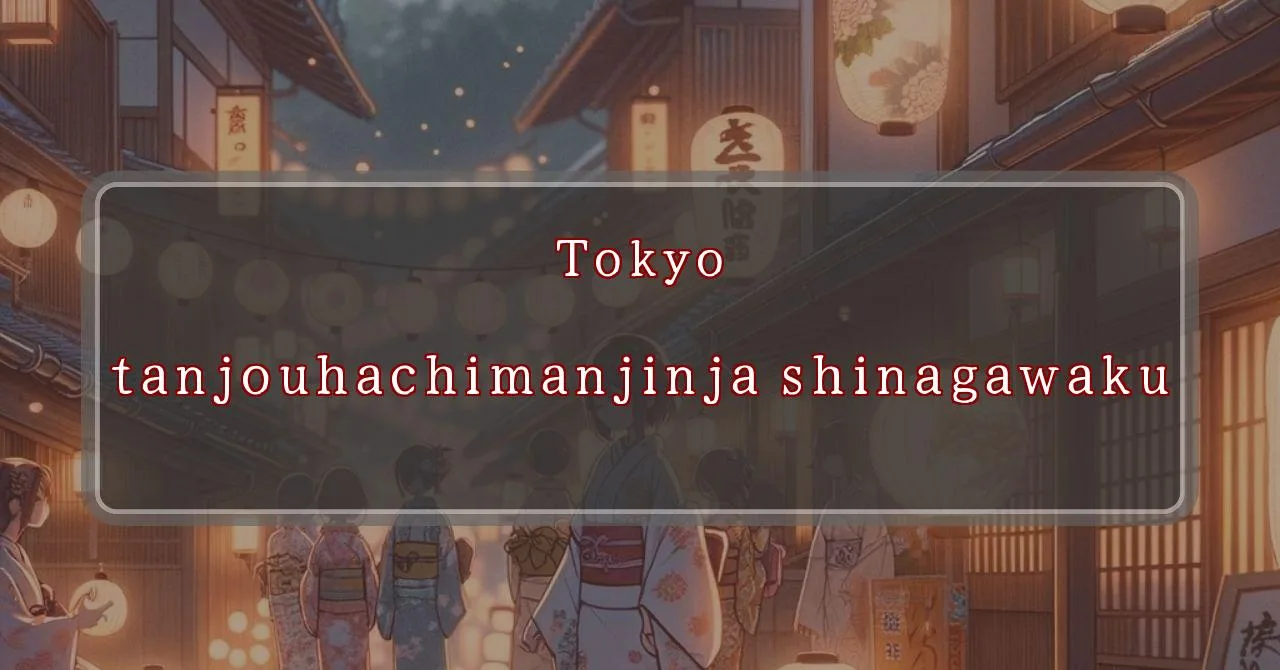Gleaming lights dance at night festival
Basic Information
Tanjō Hachiman Shrine is a Hachiman shrine located in Kamiosaki, Shinagawa Ward, Tokyo. It is a shrine with a history of over 500 years, and it is said that it was founded in the Bunmei era (1469-1487) by Ōta Dōkan, a samurai and military commander who played a key role in the construction of Edo Castle.
- Address: 2-13-36 Kamiosaki, Shinagawa-ku, Tokyo 141-0021
- Phone Number: 03-3446-8666
- Access: 3-minute walk from Meguro Station on the JR Yamanote Line, Tokyu Meguro Line, Tokyo Metro Namboku Line, and Toei Mita Line
- Festival Days: October 7th (Sat) and 8th (Sun), 2023
Main Events and Attractions of the Festival
The Tanjō Hachiman Shrine Festival is a lively and colorful event that attracts many visitors each year. The festival features a variety of events and attractions, including:
Mikoshi Procession
One of the main highlights of the festival is the mikoshi procession. On the second day of the festival, a portable mikoshi shrine is carried through the streets of the neighborhood by a team of bearers. The mikoshi is decorated with colorful tapestries and streamers, and it is accompanied by music and dancing.
Yatai (Food Stalls)
During the festival, a number of yatai (food stalls) are set up in the shrine grounds. These stalls sell a variety of traditional Japanese foods, such as yakitori (grilled chicken skewers), takoyaki (octopus balls), and taiyaki (fish-shaped cakes filled with sweet red bean paste). There are also a number of stalls selling souvenirs and crafts.
Kagura Performance
On both days of the festival, there is a kagura performance held at the shrine. Kagura is a traditional Japanese Shinto dance that is performed to entertain the gods and bring good luck. The performance is accompanied by music and singing, and it is a beautiful and moving sight to behold.
Fireworks Display
On the evening of the second day of the festival, there is a fireworks display held at the shrine. The fireworks are set off over the shrine grounds, and they create a spectacular show of light and color. The fireworks display is a fitting end to the festival, and it is a great way to celebrate the arrival of autumn.
Blessings and Deities
Tanjō Hachiman Shrine is dedicated to the deity Hachiman, the god of war and archery. Hachiman is one of the most popular deities in Japan, and he is revered by people from all walks of life. He is often depicted as a samurai warrior, and he is said to be the protector of Japan and its people.
- Hachiman: God of war and archery, protector of Japan
- Jingo Kogo: Empress consort of Emperor Chūai, Hachiman’s mother
- Takeuchi no Sukune: Legendary warrior and statesman, Hachiman’s father
Origin and History
The origins of Tanjō Hachiman Shrine are unclear, but it is believed to have been founded in the Bunmei era (1469-1487) by Ōta Dōkan, a samurai and military commander who played a key role in the construction of Edo Castle. According to legend, Dōkan’s wife was pregnant at the time, and he prayed to Hachiman for a safe delivery. His wife eventually gave birth to a healthy baby boy, and Dōkan built the shrine to express his gratitude to Hachiman.
- Founded: Bunmei era (1469-1487)
- Founder: Ōta Dōkan, samurai and military commander
- Reason for founding: Dōkan prayed to Hachiman for a safe delivery for his wife, and his prayers were answered
Tips and Notes for Visitors
Here are some tips and notes for visitors to Tanjō Hachiman Shrine:
- Hours: The shrine is open from 9:00 AM to 5:00 PM every day.
- Admission: Admission to the shrine is free.
- Dress code: There is no specific dress code for visiting the shrine, but it is considered respectful to dress modestly.
- Photography: Photography is permitted within the shrine grounds, but please be respectful of other visitors and avoid taking pictures of people without their permission.
- Smoking: Smoking is not permitted within the shrine grounds.
Parking Information
There is no dedicated parking lot for Tanjō Hachiman Shrine. However, there are a number of coin-operated parking lots in the surrounding area.
Popular Stalls and Food Carts in Recent Years
| Type of Stall | Description |
|---|---|
| Takoyaki | A staple at Japanese festivals. Characterized by a crispy outside and a creamy inside. |
| Jaga Butter | A simple yet popular snack of hot potatoes lavishly topped with melted butter. |
| Baby Castella | Small castella cakes, sweet and fluffy treats enjoyed by children and adults alike. |
| Grilled Ayu with Salt | Fresh ayu fish grilled whole with salt, a savory taste of Japanese summer. |
| Shaapin | A unique gourmet item influenced by foreign cuisine, with a chewy skin wrapping the filling. |
| Okonomiyaki | A Japanese grilled dish where you often choose your own ingredients for a personalized flavor. |
| Cotton Candy | A fluffy, sweet snack that’s extremely popular with children. |
| Chocolate Banana | A banana coated in chocolate, a fun and visually appealing dessert. |
| Kushiyaki | Various types of ingredients skewered and grilled, an easy-to-enjoy snack. |
| Yakisoba | Fried noodles mixed with a special sauce, a fast food favorite in Japan. |



